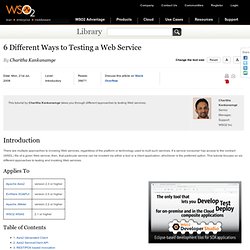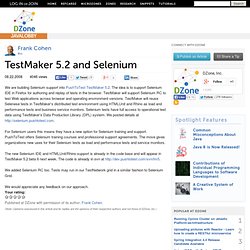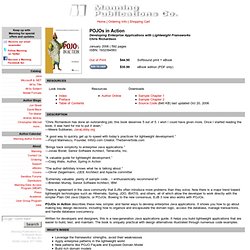

6 Different Ways to Testing a Web Service. There are multiple approaches to invoking Web services, regardless of the platform or technology used to built such services.

If a service consumer has access to the contract (WSDL) file of a given Web service, then, that particular service can be invoked via either a tool or a client application, whichever is the preferred option. This tutorial focuses on six different approaches to testing and invoking Web services. Applies To Table of Contents In this tutorial, we invoke a public Web service hosted at www.webservicex.net. As the service consumer, we have to construct the above SOAP request using any of the available tools. 1. Apache Axis2 provides a useful code generation tool referred to as WSDL2Java, that can be used to generate client stubs (proxy) in order to interact with Web services.
Compile and run the client. 2.Axis2 ServiceClient API In this approach, we will construct the payload of a request SOAP message using Axis2 serviceClient. Le blog de Seb. Testing IT by uncle MAT. Testissimo - Le site du test logiciel. TestMaker 5.2 and Selenium. We are building Selenium support into PushToTest TestMaker 5.2.

The idea is to support Selenium IDE in Firefox for authoring and replay of tests in the browser. TestMaker will support Selenium RC to test Web applications across browser and operating environment versions. TestMaker will reuse Selenese tests in TestMaker's distributed test environment using HTMLUnit and Rhino as load and performance tests and business service monitors. Selenium tests have full access to operational test data using TestMaker's Data Production Library (DPL) system. We posted details at For Selenium users this means they have a new option for Selenium training and support. The new Selenium IDE and HTMLUnit/Rhino support is already in the code base and will appear in TestMaker 5.2 beta 6 next week. We added Selenium RC too. We would appreciate any feedback on our approach. (Note: Opinions expressed in this article and its replies are the opinions of their respective authors and not those of DZone, Inc.)
SaloméTMF Wiki - Main. Open source software testing tools. POJOs in Action. “Chris Richardson has done an outstanding job; this book deserves 5 out of 5.

I wish I could have given more. Once I started reading the book, it was hard for me to put it down.” —Meera Subbarao, JavaLobby.org “A good way to quickly get up to speed with today’s practices for lightweight development.” —Floyd Marinescu, Founder, InfoQ.com Creator, TheServerSide.com “Brings back simplicity to enterprise Java applications.” “A valuable guide for lightweight development.” “The author definitely knows what he is talking about.” “Extremely valuable, plenty of sample code... There is agreement in the Java community that EJBs often introduce more problems than they solve. POJOs in Action describes these new, simpler, and faster ways to develop enterprise Java applications. Written for developers and designers, this is a new-generation Java applications guide. Chris Richardson is a developer and architect with over 20 years of experience. "A solid, valuable and easy-to-read work"--JavaRanch. Enterprise Java Community: Testing a persistent domain model.
Note: This excerpt is taken from Chapter 4 of POJOs in Action, from Manning Publications.

Every six months, Anne-Marie, who is my dental hygienist, gives me the same lecture on the importance of flossing. And each time, I half-heartedly promise that I will make more of an effort - but I never keep that promise. Some developers treat testing in the same way I treat flossing: It's a good idea but they either do it with great reluctance or not at all. Nevertheless, testing is a key part of the software development process, and just as flossing prevents dental decay, testing prevents software decay. The persistent layer, like most other application components, is not immune to decay and so requires testing.
The second challenge is effectively testing the persistent domain model while minimizing the amount of time it takes for the tests to run. In this section you will learn about the different kinds of ORM bugs and how to write tests to detect them.